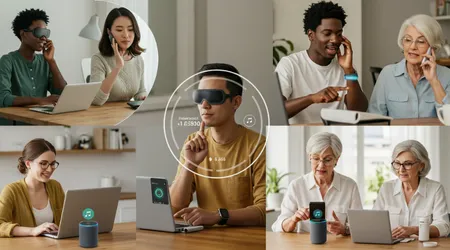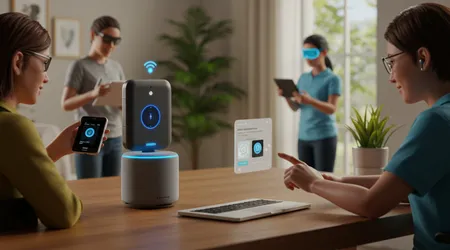How Voice Assistants Are Being Adapted for Accessibility

Voice assistants like Siri, Alexa, and Google Assistant are transforming accessibility, enabling people with disabilities to interact with technology seamlessly.
In 2025, these tools have evolved beyond simple commands, becoming lifelines for independence.
From aiding visually impaired users to supporting those with motor challenges, voice assistants are redefining how we navigate digital spaces.
This article explores their adaptations, real-world impact, and future potential, blending innovation with human-centered design. Why wouldn’t we want technology to empower everyone?
The Evolution of Voice Assistants for Accessibility
The journey of voice assistants began with basic tasks like setting alarms. Today, they’re sophisticated tools for accessibility.
Natural language processing advancements allow nuanced understanding, critical for users with speech impairments.
For example, Google’s Project Euphonia refines voice assistants to recognize atypical speech patterns, offering tailored responses. This isn’t just tech it’s a bridge to inclusion.
Precision matters in accessibility. Voice assistants now integrate with screen readers, enabling blind users to navigate apps effortlessly.
Consider Maria, a visually impaired student who uses Alexa to access textbooks hands-free.
Such integrations highlight how voice assistants empower independent living with practical, real-time solutions.
++ From Prototypes to Daily Tools: The Evolution of Assistive Tech
Moreover, multimodal interfaces are emerging. Combining voice with haptic feedback, these systems assist users with sensory impairments.
Microsoft’s 2025 Ability Summit showcased prototypes where voice assistants guide deaf users via vibrations, proving technology’s adaptability.
This evolution reflects a commitment to universal access, driven by user needs.

Enhancing Independence Through Voice-Controlled Ecosystems
Smart homes are game-changers for accessibility, and voice assistants are their heart. They control lights, thermostats, and locks, reducing physical barriers.
John, a wheelchair user, relies on Google Assistant to manage his home, enhancing his autonomy. This isn’t luxury it’s necessity.
Integration with assistive devices amplifies impact. Voice assistants sync with hearing aids or prosthetics, offering real-time adjustments.
Also read: Eye-Tracking Technology: A Game-Changer for ALS Patients
A 2024 study by WebFX noted 88.8 million U.S. users rely on Google Assistant, many for accessibility needs. This statistic underscores the widespread reliance on these tools.
Beyond homes, voice assistants connect to public systems. Transit apps in cities like London use Alexa to provide audio schedules, aiding visually impaired commuters.
These ecosystems show how technology fosters independence, turning environments into allies for those with disabilities.
| Feature | Accessibility Benefit | Example Platform |
|---|---|---|
| Speech Recognition | Understands atypical speech | Google Assistant |
| Smart Home Control | Hands-free environment management | Amazon Alexa |
| Screen Reader Integration | Navigates digital interfaces for blind users | Siri |
| Multimodal Feedback | Combines voice with haptic cues for deaf users | Microsoft Cortana |
Addressing Accessibility Gaps with AI Innovation
Despite progress, gaps persist. Voice assistants struggle with diverse accents or complex queries, frustrating users with cognitive disabilities.
AI is tackling this. Google’s 2025 updates, announced on their blog, enhance voice assistants for non-English African languages, broadening global access.
Inclusion demands such innovation.
Training data diversity is key. Developers now prioritize datasets reflecting varied speech patterns, as seen in Apple’s Siri updates for dysarthric users.
Imagine a voice assistant misunderstanding a stroke survivor AI must evolve to prevent this. These efforts ensure no one is left behind.
Ethical AI also plays a role. Privacy concerns, especially for vulnerable users, drive encrypted voice assistant interactions.
Microsoft’s Azure AI Speech, integrated into assistive tools, emphasizes secure data handling. This balance of innovation and trust is vital for accessibility’s future.
The Role of Voice Assistants in Education and Work
In education, voice assistants break barriers. They read aloud texts, answer queries, and organize schedules for students with disabilities.
Picture Sarah, a dyslexic learner, using Siri to summarize articles, boosting her confidence. These tools make learning equitable.
Workplaces also benefit. Voice assistants transcribe meetings or automate tasks, aiding employees with motor impairments.
Amazon’s Alexa+ now offers real-time captioning, a boon for deaf professionals. This fosters inclusive environments where talent shines, not limitations.
Looking ahead, voice assistants could integrate with augmented reality for real-time guidance. Imagine a visually impaired worker using a voice assistant to navigate a warehouse via audio cues.
Such innovations promise to redefine accessibility in professional and academic spheres.
Future Horizons: Predictive and Personalized Assistance
The future of voice assistants lies in anticipation. Predictive AI, showcased at Amazon’s 2025 Devices event, enables voice assistants to foresee user needs.
For a Parkinson’s patient, this might mean pre-adjusting home settings, enhancing comfort. It’s like a friend who knows you deeply.
Personalization is equally transformative. Voice assistants now learn user preferences, adapting to unique speech or mobility needs.
Apple’s 2025 Siri updates allow custom command sets, empowering users with autism to tailor interactions. This isn’t just tech it’s empathy in code.
Collaboration drives progress. Partnerships, like Tobii Dynavox with Microsoft, integrate voice assistants into communication aids, amplifying voices of those with ALS.
These advancements signal a future where voice assistants are universal tools, seamlessly inclusive.
Challenges and Ethical Considerations

Yet, challenges loom. Voice assistants risk over-reliance, potentially isolating users if systems fail. Developers must ensure redundancy, like backup manual controls.
Accessibility isn’t a one-size-fits-all solution it demands flexibility.
Bias in AI remains a hurdle. If voice assistants misinterpret marginalized voices, they exclude. Ongoing audits, as Google DeepMind advocates, are crucial to eliminate bias.
Ethical design ensures voice assistants serve all, not just the majority.
Cost is another barrier. Advanced voice assistants like Alexa+ require subscriptions, limiting access for low-income users.
Subsidized models, as proposed by accessibility advocates, could bridge this gap. Inclusion must be affordable to be meaningful.
Conclusion: A Call for Inclusive Innovation
Voice assistants are more than gadgets they’re catalysts for independence, education, and equity. From smart homes to workplaces, they empower millions, yet gaps in access and ethics persist.
The 88.8 million U.S. users of Google Assistant highlight their impact, but innovation must reach further.
Like a lighthouse guiding ships, voice assistants illuminate paths to inclusion, but only if we prioritize diversity, affordability, and trust.
Let’s build a future where technology lifts every voice. What’s stopping us from making accessibility universal?
Frequently Asked Questions
Q: How do voice assistants help visually impaired users?
A: They integrate with screen readers, read texts aloud, and control devices, enabling independent navigation of digital and physical spaces.
Q: Are voice assistants secure for users with disabilities?
A: Yes, encrypted systems like Microsoft’s Azure AI Speech prioritize data privacy, though users should verify platform security features.
Q: Can voice assistants understand atypical speech?
A: Advances like Google’s Project Euphonia improve recognition of speech impairments, though challenges with diverse accents remain.
Q: What’s the cost barrier for voice assistants?
A: Premium features, like Alexa+’s $19.99/month, can limit access. Subsidized options are needed for equitable use.
Q: How do voice assistants support workplace inclusion?
A: They transcribe meetings, automate tasks, and offer captioning, aiding employees with motor or hearing impairments.
